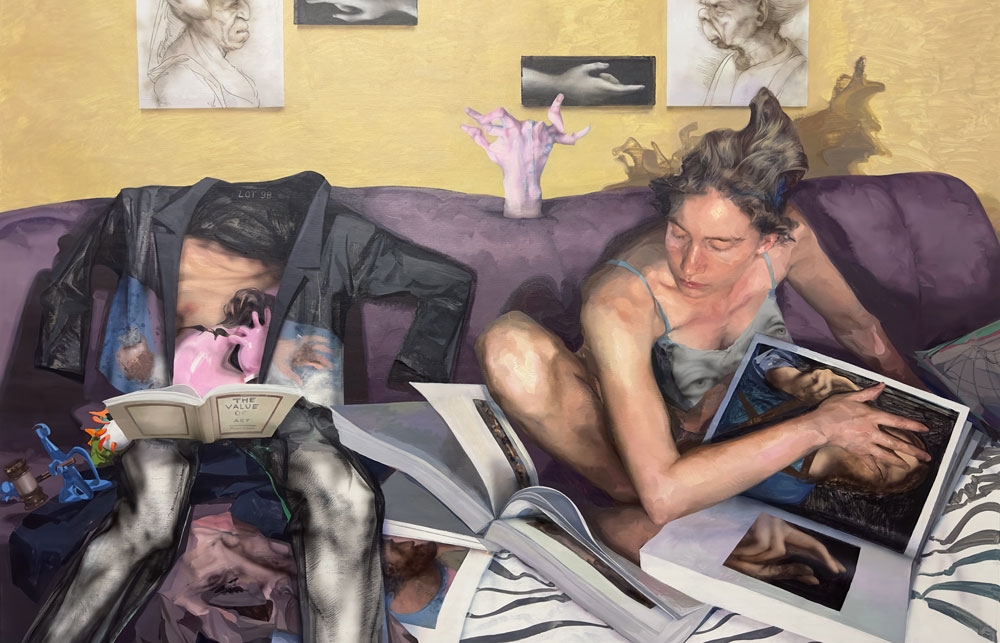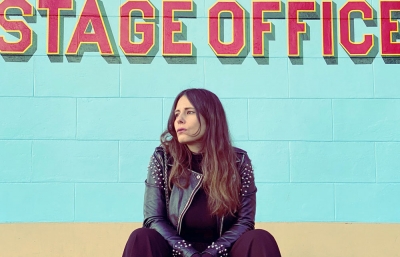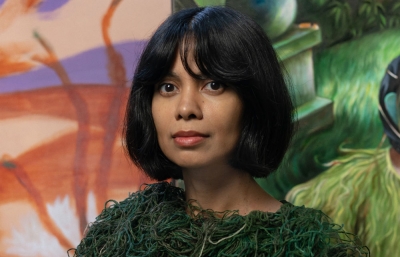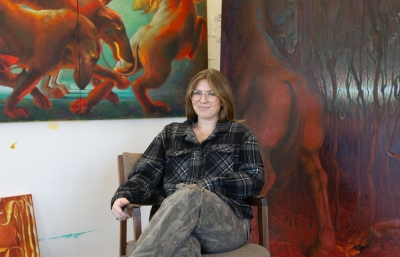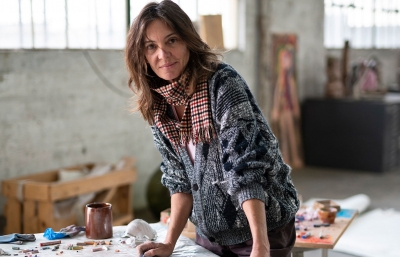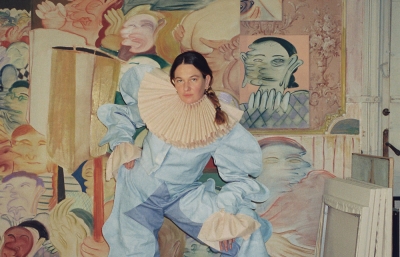Deng "Demo" Shiqing
The People Listener
Interview by Charles Moore
Whether in-person or in the movies, Deng “Demo” Shiqing has a habit of listening to other people’s conversations. A recent viewing of Emerald Fennell’s black-comedy thriller Saltburn echoes the same dark undertones that inspire her own work. Human dialogue is a key influence for the artist, who strives to infuse her canvases with humor as she crafts narratives starring compelling characters—her subjects—and perfects her trademark blend of playful criticism. Each one of Demo’s paintings tells a unique story, rooted in historical references, fashion photography, and contemporary imagery. The artist notes that she wants viewers to be entertained, all while carefully considering what they see. Throughout, she makes a point of keeping her work accessible. “I don’t want to push people away,” she says. Rather, she hopes to entertain them.
The artist is the first to admit her work has evolved since she immigrated to New York from China in 2016. After completing her BFA from the Central Academy of Fine Arts there two years prior, the air pollution in Beijing was impacting her health, and she sought a change of pace, ultimately earning her MFA from the New York Academy of Art in 2018. Demo explains that she honed her painterly technique in China, where students are trained to make art in a uniform traditional style. However, she sought true freedom in the U.S. and only then found her voice. The artist is experimental in the way she approaches her work, leveraging different materials like spray paint, maybe a layer of acrylic, and only later the oil paint she once used exclusively. The result is dynamic and quite seamless; subtlety is a high priority for Demo.

With her deep appreciation of Michelangelo and the Old Masters, the artist also incorporates a contemporary aesthetic into her classical training. She appreciates Rembrandt and Degas yet feels drawn to peers like Adrian Ghenie, whose color selections, technological focus, and ability to toe the line between figuration and abstraction resonate with her. While early in her career she maintained what she calls a “fine art standard,” Demo has begun pushing those boundaries more and more—examining topics like ASMR, escapist fashion, and playful criticism of the art world.
Looking forward, the emerging artist anticipates a busy yet fulfilling 2024. She may show her work at Future Fair, and she’s thrilled with the opportunity to present a new series with C+N Canepaneri in Milan this summer. Inspired by The Lost Leonardo, a 2021 HBO documentary exploring the mystery behind Leonardo da Vinci’s Salvator Mundi (c. 1499-1510)—allegedly the world’s most expensive painting—Demo began to research the concept of forgery and developed her idea into a 15-work exhibition. There, she considers what makes a painting valuable, worthless, or somewhere in between. The artist recognizes that value is fluid and subjective and that profit isn’t the ultimate criterion. In this same vein, she recognizes the true value of her technical training in China, though she wishes she’d left for New York sooner. In the U.S., Demo sees paintings in real life, not just as images in a book. And few experiences offer greater value.

Charles Moore: How did your time at the Central Academy of Fine Arts shape your initial approach to art?
Deng “Demo” Shiquing: I mean, before I was in China, I was studying art for a long time, because in China you have to train really hard to get into art college. The exams are rigorous, and you need to practice so many times. I got my technical skills from China. Around 2016, I went to New York to study because in China there is very heavy air pollution. I felt like I needed to leave for my health issues. I wanted to change the environment. I chose the New York Academy of Art because they focus on figurative art.
At the Academy, they also paint models every day in the class, but the difference is you can do whatever you want. It's not like everybody is doing the same thing. In China, everyone trained the same way. They paint the same style. They're very academic. In the U.S., it’s very different. The students in the US are very bold, experimenting with so many things. That really inspires me too. Everybody's doing their own thing. I feel like I got inspired in that environment. I think the teachers helped me too. By my second year, I kind of found my way. I saw a fashion exhibition by Rei Kawakubo at The Met, and they had very cool clothes. That show really inspired me, so I started to design my own clothes for my friends in my painting. I just made up the clothes and experimented with the shapes, color, texture, all in that kind of playful way, and expressed their character through the clothes. So yeah, around that time I gradually found my own way; it's something like myself, like my personality, my dark humor.
You relate a very striking difference in artistic training and philosophy in your experiences with the Central Academy of Fine Arts and the New York Academy of Fine Arts.
I think the big difference is freedom, and that gives you more courage to do whatever you feel like, not what other people think is good or bad. Back in China, they have academic standards of what is good and what is bad, so you just avoid the bad and do what they think is good. The teachers are more strict, and if you don't follow their instructions, they might give you a bad grade.
Let’s talk about your materials and technique. What guides your choices?
I looked at the work by other artists, so I mean, it’s sometimes from looking at another artist, to be honest. They might use acrylic and airbrush, and I’ll think, “That's cool; let me try it!” Before, I never used acrylic. I had always used the very traditional medium of oil only.

Are you using a lot of acrylics in your work?
Yeah. I use all different kinds of mediums, and I don't use the same thing every time. Only if it’s necessary.
Who are the artists or individuals, past or present, that inspire you the most, and why?
I think it's Michelangelo because that's from the very beginning when I studied art. I studied through the Old Master books. That's how I started. I started to copy the Old Master paintings and drawings. So, they have a deep influence on me. It's like you cannot get rid of it; you have that influence forever. It shaped my aesthetic. But I have a lot of favorite artists. I like Jan van Eyck, Holbein, Rembrandt, Degas, Francis Bacon, Gustav Klimt, and Egon Schiele. For living artists, I really love Adrian Ghenie’s paintings.
What do you like about Ghenie’s paintings?
I mean, he's so free. His brushstroke is very bold and confident, and his colors are nice. I really love his color choices. I like something between abstract and figurative, and he's doing exactly that. It gives you a lot of imagination. I just saw his new show in New York. I love his subject matter. He chooses the topic of technology, so it’s very present and critical. I love it. I think my favorite is the one with the Velasquez painting in the background in the Prado Museum.
Let’s talk about this newer work. Historically speaking, your paintings often tell a story. How do you develop these narratives? I feel like you incorporate a lot of humor into your work too. Tell me about how you developed these narratives and how you play with the work through humor.
Every time I search a lot of photos, like historical references. I need to understand that first. And then I also search through a lot of fashion photos or whatever on the internet. It's not like meditating and closing my eyes until I find the idea. I just keep looking or just go outside. And sometimes I see something. I just have an idea from that; maybe it's from street fashion, maybe from a book, maybe from internet photos or other artist paintings. And because my personality is funny, it's easy for me to do funny things, but sometimes I also think I don't want to do it too much. It's like control. Most of my work themes are pretty dark. I don't want to make it too serious because it’s not fun. I just want people to enjoy it and feel entertained by seeing what I do. It doesn’t matter if they understand the story behind it. I think it's easy for people to enter into the story when the work has humor. You don't want to push people away.

Do you think finding humor in some of these cultural things comes from the freedom you got when you moved to New York?
Yeah, because before I barely painted anything fun, I always had that boundary. Oh, the fine art—the painting was so serious, like old masterpieces in museums. But it was limiting me. I was always drawing funny characters when I was a kid, and now I'm more open.
There's also been an evolution in your work from when I first started looking at it a few years ago, and it's clear that some of your cultural heritage is represented in your newer work. Was that important for you? Was it a breakthrough to start incorporating Asian culture in your work more than before?
I think maybe because I got a little bit farther away from China, I haven’t lived there for, like, seven years. I feel like when you get a little bit farther away, you see things clearer. I got a little bit more interested in it than before. Before I thought, being removed from my country also removed my interest in my own culture. I always went straight to Western paintings sections in museums and left. But now I start to look around in other sections. So maybe that shows I'm a little bit more open than before. I don't know why; maybe I’m getting old.
Are there any other sources of inspiration, like literature, music, or nature, that you find coming out in your work?
Nature or movies. I love movies, but I don't listen to music that much. I always listen to other people talking.
What type of movies are you watching?
I mean, all kinds, except Marvel and sweet romance. Recently, I watched Saltburn; it's not great, but the cinematography and costume design are nice. I got a few ideas on how to dress new characters in my paintings from watching that movie.

“I feel like when you get a little bit farther away, you see things clearer.”
How do you hope viewers react to your work, and what do you want them to take away from it?
Of course, I really want them to enjoy it visually, without any need for explanation. Sometimes my paintings are hard for the viewer to understand because I don’t want my work to be very straight forward. So, whatever it is about, it doesn't really matter to me. If they enjoy what they see in the painting or they're like, Oh, it is interesting, it’s always fun. That feels good for me. I mean, if they want to know more and discover the little details in paintings, that would be great too. And I am always happy to have opportunities to go deeper into the visual language of painting and describe what I’m thinking and why I painted a certain thing in a certain way.

Are there any current projects or exhibitions you're working on?
I might show some of my work at the Future Fair later this year in New York. And I have a solo exhibition this summer in Milan with C+N Canepaneri. That will have the Forgery series.
Tell me about the Forgery series.
So the first painting I made was when I saw this documentary on HBO about the DaVinci painting Salvador Mundi is selling for, like, a billion dollars. They have a documentary about whether it is real or not. They invited a lot of art critics, experts, and collectors to talk about it. That documentary made me interested in this subject matter. I started to make a painting about Salvador Mundi. But my usual routine was always jumping to totally different ideas so fast. I remembered that when I just finished that one, I was about to paint something else, and a curator gave me the suggestion that I should expand my idea. So that's how this series started.
I began by searching a lot of documents, photos, and stories about forgery, and then I made 15 pieces in that series. I think it's very interesting because not a lot of people are approaching that subject matter, maybe because they're in this industry. You know what I mean? It's hard to criticize, but I feel like that's exactly what I think. I just don't like how the market goes. That's like what I really wanted to criticize. I totally understand, but I don't like it. Not everything should be about profit.

And then what advice would you give to aspiring artists who are just starting, especially those moving between cultural art scenes like you've done?
Just trust your own instinct. And if you really believe in yourself, then everything will work out how it is supposed to.
Dengshiqing.com // This interview was originally published in our SPRING 2024 Quarterly

